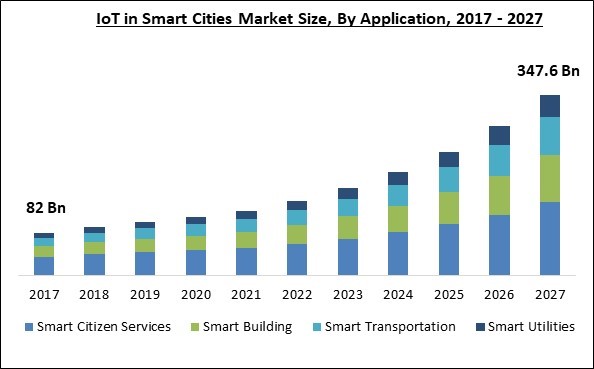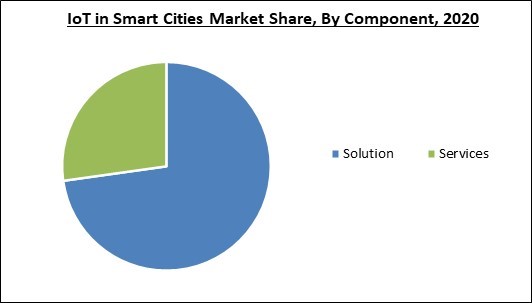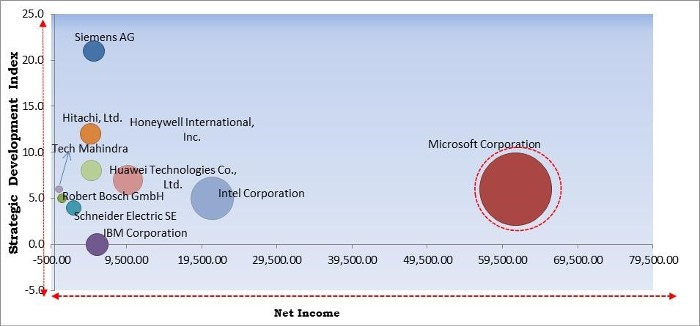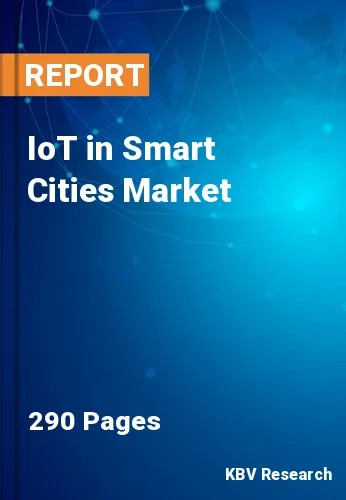The Global IoT in Smart Cities Market size is expected to reach $347.6 billion by 2027, rising at a market growth of 18.8% CAGR during the forecast period.
The Internet of Things (IoT) is a term that describes the rapidly expanding use of technological gadgets. These devices use an internet connection to communicate and interact with others, and they may be monitored and controlled remotely. Cities can now use data to better manage traffic, regulate pollution, make better use of infrastructure, and keep inhabitants safe and clean with the help of this technology.
IoT has the ability to alleviate urbanization's pressures by providing a new experience for city residents and making day-to-day life more comfortable and secure. Residents in smart cities can be benefitted from improved access to water, clean air, sanitation, and waste management due to the Internet of Things. Smart cities solutions can be created using connected internet technologies and big data, which can be utilized to address problems, improve inhabitants' quality of life, and reduce resource usage.
The Internet of Things (IoT) in smart cities is the use of smart technologies and connected devices to collect real-time data about the external environment across the city. Some of the growth factors for the overall market are rising urbanization, a surge in demand for efficient infrastructure in metropolitan areas, increased demand for energy-efficient resources, traffic management, waste management, public safety, and security.
The concept of smart cities has gained traction as a result of greater awareness about smart goods, and it is owing to the bridging technologies. In the last few years, there has been increased spending by a variety of dedicated governing organizations, central/federal governments, and local governments. In the deployment of smart city projects, infrastructure investments, governance arrangements, technical ecosystems, and finance and funding methods all play essential roles.

The COVID-19 outbreak has had a significant impact on markets and customer behavior, as well as economies and communities, in a short period of time. The healthcare, telecommunications, media and entertainment, utilities, and government verticals work around the clock to provide essential services to everyone. In the face of the COVID-19 pandemic, the telecom sector, in particular, is playing a critical role in supporting countries' digital infrastructure around the world.
According to Fujitsu's Global Digital Transformation Survey, offline businesses suffered the most damage, while online businesses saw a rise in demand and revenue. Innovative IoT-based smart city solutions, which can be efficiently combined with big data, analytics, cloud, security, and network connectivity, are in high demand across a wide range of industries.
Multiple technologies, such as the Internet of Things (IoT), cloud, mobility, data communications, and artificial intelligence (AI), contribute to the infrastructure of smart cities. In recent years, increased use of these technologies has enabled greater connectivity, leading to a complete redevelopment of the smart city ecosystem. There is interest in a variety of developing technologies from a technological standpoint, with machine learning/data analytics, IoT, and cybersecurity projected to have the greatest impact on smart city projects over the next few years.
In addition, one of the key trends of the market is the development of 5G and NB-IoT technologies. The smart government, as well as other sectors, would become extremely intelligent and self-governing with the developments in the 5G and IoT. In the case of smart transportation, the system would use the cloud to collect data from numerous sources and share it with a centralized control center.
The rapid growth of IoT and smart city initiatives is increasing the demand for smart security systems, such as PIDS (Perimeter Intrusion Detection System). In addition, there is a strong emphasis on effective energy management technologies to ensure accurate metering and reduce waste. IoT technology suppliers are being invited to contribute to smart city transportation infrastructure to enable adequate monitoring and management, reduce carbon emissions, and provide better route planning and optimization.
Many countries are currently heavily investing in technology in order to modernize their existing infrastructure. The Indian government, for example, invested a hefty amount to upgrade 100 current cities across the country to smart cities. In addition, the US government also pledged a significant investment in smart city technologies in the year 2016. As a result, smart city initiatives are projected to aid the growth of the IoT market in smart cities. According to an article published in February 2020 by the American Society of Mechanical Engineers, the Singapore government plans to install intelligent, energy-efficient lighting on all public roads by 2022, as well as solar panels on the rooftops of 6,000 buildings.
Project funding for large initial capital investment is one of the primary hurdles for this industry. The national/local governments have taken on the primary task of extensively investing in the transformation of city infrastructure. It is quite simple to understand how, even if governments have the need, vision, and clarity for such reforms, a lack of budgetary allocations for large-scale implementations slows down the transformation process, either directly or indirectly. Such large investments may increase the economic strain on debt-ridden states or local governments, putting future general budgets at risk.
Before adopting new technology deployments, such as IoT, government regulatory bodies must monetize these systems and ensure a large return on investment. As a result, the cost of converting existing infrastructure serves as a deterrent to governments continuing to make large-scale expenditures.

Based on Component, the market is segmented into Solution and Services. The Service segment procured a significant revenue share of the IoT in Smart cities market in 2020. Service providers in the IoT in Smart Cities industry provide a variety of services. These services make it easier for businesses to adapt, grow, and maintain ongoing activities. Individual development and training are provided by IoT in Smart City providers to customers, partners, support teams, marketing teams, and workers.
Based on Solution Type, the market is segmented into Remote Monitoring, Data Management, Security, Real-time Location System, Reporting & Analytics, and Network Management. The Data Management segment acquired a significant revenue share of the IoT in Smart cities market in 2020. This is because real-time data is received, analyzed, and managed by cloud-based IoT apps to assist municipalities, businesses, and individuals in making better decisions that improve quality of life. The blueprint for smart cities is smart data management. In addition, data management makes data sharing, new product development, long-term growth, cost reductions, and other advantages possible. From next-generation accessibility to linking people and visitors, data management supports all aspects of a smart city.
Based on Services type, the market is segmented into Professional Services and Managed Services. In 2020, the Professional services segment procured the maximum revenue share of the IoT in smart cities market. Professional services are business support services provided by professionals, specialists, or experts. There are three types of professional services: deployment and system integration, consultation, and support and maintenance services. The expanding trend of using IoT professional services to minimize Capital Expenditure (CAPEX) and Operational Expenditure (OPEX), as well as the desire for highly tailored IoT services in the industrial and transportation sectors, are the main drivers for IoT professional services. In addition, digital transformation services are being used at a faster rate in a variety of industries, including transportation, utilities, buildings, and others.
Based on Application, the market is segmented into Smart Citizen Services, Smart Building, Smart Transportation, and Smart Utilities. In 2020, the smart citizen services segment obtained the largest revenue share of the IoT in Smart Cities market. This is because the Internet of Things is redefining citizen services. It can be used in a variety of settings, including healthcare, education, and public safety. Smart education solutions have undergone a rapid shift, with companies moving toward mobile technology. Using IoT, educational institutions may not only improve their learning experiences but also manage their OPEX and CAPEX more efficiently. The use of Interactive White Boards (IWBs), projectors, and printers are considered as a driver for change in the education industry, and the growing number of connected medical devices and the prevalence of smartphones have both contributed considerably to the rise of the Internet of Things. As a result, governments all over the world are aggressively implementing IoT to improve citizen safety. Governments have been embracing IoT-based smart city solutions and services to reduce crime rates and address the growing number of illicit activities.
| Report Attribute | Details |
|---|---|
| Market size value in 2020 | USD 112.1 Billion |
| Market size forecast in 2027 | USD 347.6 Billion |
| Base Year | 2020 |
| Historical Period | 2017 to 2019 |
| Forecast Period | 2021 to 2027 |
| Revenue Growth Rate | CAGR of 18.8% from 2021 to 2027 |
| Number of Pages | 290 |
| Number of Tables | 463 |
| Report coverage | Market Trends, Revenue Estimation and Forecast, Segmentation Analysis, Regional and Country Breakdown, Competitive Landscape, Companies Strategic Developments, Company Profiling |
| Segments covered | Component, Application, Region |
| Country scope | US, Canada, Mexico, Germany, UK, France, Russia, Spain, Italy, China, Japan, India, South Korea, Singapore, Malaysia, Brazil, Argentina, UAE, Saudi Arabia, South Africa, Nigeria |
| Growth Drivers |
|
| Restraints |
|
Based on Regions, the market is segmented into North America, Europe, Asia Pacific, and Latin America, Middle East & Africa. In 2020, North America emerged as the leading region in the overall IoT in Smart Cities market and would showcase a similar kind of trend even during the forecasting period. The economies of the United States and Canada are both stable and well-established, allowing them to invest heavily in R&D and so contribute to the development of new technology. In addition, Network operators in this region are consistently investing in expanding and upgrading their telecom networks, as well as transitioning to 5G infrastructure using technologies like cloud edge computing and network slicing, accelerating the adoption of IoT in smart cities for low-cost, strategic urban management.
Free Valuable Insights: Global IoT in Smart Cities Market size to reach USD 347.6 Billion by 2027

The major strategies followed by the market participants are Partnerships. Based on the Analysis presented in the Cardinal matrix; Microsoft Corporation is the major forerunners in the IoT in Smart Cities Market. Companies such as IBM Corporation, Tech Mahindra Limited and Schneider Electric SE are some of the key innovators in the Market.
The market research report covers the analysis of key stake holders of the market. Key companies profiled in the report include IBM Corporation, Schneider Electric SE, Siemens AG, Microsoft Corporation, Intel Corporation, Hitachi, Ltd., Tech Mahindra Limited, Huawei Technologies Co., Ltd. (Huawei Investment & Holding Co., Ltd.), Robert Bosch GmbH, and Honeywell International, Inc.
By Component
By Application
By Geography
The global loT in smart cities market size is expected to reach $347.6 billion by 2027.
A growing number of smart city projects are driving the market in coming years, however, IoT in smart cities necessitates large initial investments limited the growth of the market.
IBM Corporation, Schneider Electric SE, Siemens AG, Microsoft Corporation, Intel Corporation, Hitachi, Ltd., Tech Mahindra Limited, Huawei Technologies Co., Ltd. (Huawei Investment & Holding Co., Ltd.), Robert Bosch GmbH, and Honeywell International, Inc.
The Solution market acquired maximum revenue share in the Global IoT in Smart Cities Market by Component 2020; thereby, achieving a market value of $238.1 billion by 2027.
The North America is the fastest growing region in the Global IoT in Smart Cities Market by Region 2020, and would continue to be a dominant market till 2027.
Our team of dedicated experts can provide you with attractive expansion opportunities for your business.

